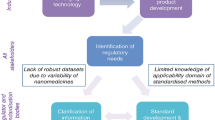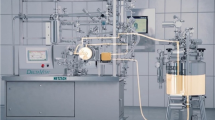Abstract
Purpose. The purpose of this study was to establish an automated approach to salt selection and to search for unique trazodone salts for new applications.
Methods. Automated procedures were developed on a Biomek 2000 automation workstation with stacker and plate reader capabilities. Trazodone was dispensed into 96-well plates, and an automated method was set up to form 104 trazodone salts. Salts were observed under a polarized light microscope to determine crystallinity. After stepwise eliminations, the remaining salts were scaled-up and subjected to differential scanning calorimetry (DSC), powder x-ray diffraction (PXRD), hygroscopic, pH-solubility, density, surface area, and particle size analyses.
Results. Oils formed in several cases resulting in preliminary elimination of mesyl and esyl salts and four crystallizing solvents. Crystallinity was observed in 34 of 44 scaled-up trazodone salts. PXRD, DSC, and hygroscopic analyses indicated a number of new salts that were comparable in physicochemical parameters to the marketed HCl salt. Among them, the tosylate salt showed uniqueness for new applications.
Conclusions. Automated procedures can be developed to increase the efficiency of pharmaceutical salt selection. The new tosylate salt gave a unique pH-solubility profile with low solubility over the entire pH range making it a potential candidate for a suspension or prolonged action formulation.
Similar content being viewed by others
REFERENCES
R. M. Burch and D. J. Kyle. Mass receptor screening for new drugs. Pharm. Res. 8(2):141-147 (1991).
A. Alanine, M. Nettekoven, E. Roberts, and A. W. Thomas. Lead generation—enhancing the success of drug discovery by investing in the hit to lead process. Comb. Chem. High Throughput Screen. 6(1):51-66 (2003).
C. K. Atterwill and M. G. Wing. In vitro preclinical lead optimization technologies (PLOTs) in pharmaceutical development. Toxicol. Let. 127(1–3):143-151 (2002).
A. Avdeef and B. Testa. Physicochemical profiling in drug research: a brief survey of the state-of-the-art of experimental techniques. Cell. Mol. Life Sci. 59(10):1681-1689 (2002).
P. A. Bell. SNPstream (R) UHT: Ultra-High Throughput SNP Genotyping for Pharmacogenomics and Drug Discovery (vol 32, pg S70, 2001). Biotechniques 34(3):496-496 (2003).
K. H. Bleicher, H. J. Bohm, K. Muller, and A. I. Alanine. Hit and lead generation: beyond high-throughput screening. Nature Reviews Drug Discovery. 2(5):369-378 (2003).
E. H. Kerns. High-throughput physicochemical profiling for drug discovery. J. Pharm. Sci. 90(11):1838-1858 (2001).
L. H. Caporale. Chemical ecology: a view from the pharmaceutical industry. Proc. Natl. Acad. Sci. U. S. A. 92:75-82 (1995).
A.N. Hobden and T.J. Harris. The impact of biotechnology and molecular biology on the pharmaceutical industry. Proc. Royal Soc. Edinburgh. 99B(1–2):37-45 (1992).
Available: http://www.healthyplace.com/medications/trazodone.htm. Healthyplace, Inc. (2002).
Products/Prescription Products. Molipaxin CR tablets. The Pharmaceutical Journal Online. 266(7146):631(2001). www.pharmj.com/Editorial/20010505/products.html#molipaxin.
A. Dobashi. Trazodone hydrochloride. Available: http://www.ps.toyaku.ac.jp/dobashi/database/animation/t_group/trazodone_hydrochloride.html (2003).
N. Sandow. Available: http://www.rxlist.com/cgi/generic/traz_cp.htm (2003). RxList LLC.
M. Haria, A. Fitton, and D. McTavish. Trazodone. a review of its pharmacology, therapeutic use in depression and therapeutic potential in other disorders. Drugs Aging 4(4):331-355 (1994).
R. J. Bastin, M. J. Bowker, and B. J. Slater. Salt selection and optimization procedures for pharmaceutical new chemical entities. Org. Proc. Res. Develop. 4(5):427-435 (2000).
SSCI. drug product studies. amorphous form stabilization. Available: www.ssci-inc.com (2001).
Various. The United States Pharmacopeia (USP 24) and the National Formulary (NF 19), Vol. 24. The United States Pharmacopeial Convention, Inc., Rockville, MD, 2000, pp. 1913-1992.
L. W. Dittert, T. Higuchi, and D. R. Reese. Phase solubility techniques in studying the formation of complex salts of triamterene. J. Pharm. Sci. 53:1325-1328 (1964).
A. T. M. Serajuddin and D. Mufson. pH-Solubility profiles of organic-bases and their hydrochloride salts. Pharmaceut. Res. 2:65-68 (1985).
A. El-Gindy, B. El-Zeany, T. Awad, and M. M. Shabana. Spectrophotometric, spectrofluorimetric, and LC determination of trazodone hydrochloride. J. Pharm. Biomed. Anal. 26:211-217 (2001).
J. Bernstein. Polymorphism in Molecular Crystals. International Union of Crystallography: Monographs on Crystallography, Vol. 14. Oxford University Press, New York, 2002, p. 410.
M. Bowker. A Procedure for salt selection and optimization. In P. H. Stahl and C. G. Wermuth (eds.), Handbook of Pharmaceutical Salts: Properties, Selection and Use, Wiley-VCH, Zurich, 2002, pp. 161-220.
D. Giron and D. J. W. Grant. Evaluation of solid state properties of salts. In P. H. Stahl and C. G. Wermuth (eds.), Handbook of Pharmaceutical Salts: Properties, Selection and Use. Wiley-VCH, Zurich, 2002, pp. 1-80.
A. T. M. Serajuddin and M. Pudipeddi. Salt selection strategies. In P. H. Stahl and C. G. Wermuth (eds.), Handbook of Pharmaceutical Salts: Properties, Selection and Use. Wiley-VCH, Zurich, 2002, pp. 135-160.
P. H. Stahl and C. G. Wermuth. Introduction. In P. H. Stahl and C. G. Wermuth, (eds.), Handbook of Pharmaceutical Salts: Properties, Selection and Use. Wiley-VCH, Zurich, 2002, pp. 1-17.
J. K. Guillory. Generation of polymorphs, hydrates, solvates and amorphous solids. In H. G. Brittain (ed.), Polymorphism in Pharmaceutical Solids. Marcel Dekker, New York, 1999, pp. 183-226.
M. T. Ledwidge and O. I. Corrigan. Effects of surface active characteristics and solid state forms on the pH solubility profiles of drug-salt systems. Int. J. Pharm. 174(1–2):187-200 (1998).
Author information
Authors and Affiliations
Corresponding author
Rights and permissions
About this article
Cite this article
Ware, E.C., Lu, D.R. An Automated Approach to Salt Selection for New Unique Trazodone Salts. Pharm Res 21, 177–184 (2004). https://doi.org/10.1023/B:PHAM.0000012167.60180.c3
Issue Date:
DOI: https://doi.org/10.1023/B:PHAM.0000012167.60180.c3




